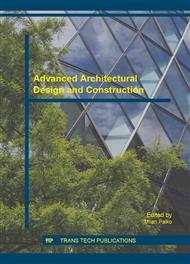[1]
Q. Li, J. Rao, P. Fazio, Development of HAM tool for building envelope analysis, Building and Environment, 44 (2009) 1065-1673.
DOI: 10.1016/j.buildenv.2008.07.017
Google Scholar
[2]
H. Huang, S. Kato, R. Hu, Y. Ishida, Development of new indices to assess the contribution of moisture sources to indoor humidity and application to optimization design: Proposal of CRI (H) and a transient simulation for the prediction of indoor humidity, Building and Environment, 46 (2011).
DOI: 10.1016/j.buildenv.2011.03.002
Google Scholar
[3]
M. Woloszyn, C. Rode, Tools for Performance Simulation of Heat, Air and Moisture Conditions of Whole Buildings, Building Simulation, 1 (2009) 5-24.
DOI: 10.1007/s12273-008-8106-z
Google Scholar
[4]
A. Janssens, S. Roels, L. Vandaele, Full scale test facilities for evaluation of energy and hygrothermal performances. Paper presented at International Workshop (2011). Brussels, Belgium.
Google Scholar
[5]
P. H. Baker, H.A.L. van Dijk, PASLINK and dynamic outdoor testing of building components, Building and Environment, 43 (2008) 143–151.
DOI: 10.1016/j.buildenv.2006.10.009
Google Scholar
[6]
P. A. Strachan, L. Vandaele, Case studies of outdoor testing and analysis of building components, Building and Environment, 43 (2008) 129–142.
DOI: 10.1016/j.buildenv.2006.10.043
Google Scholar
[7]
D. Katunský et al, Numerical analysis and measurement results of a window sill, Advanced Materials Research, 899 (2014) 147-150.
DOI: 10.4028/www.scientific.net/amr.899.147
Google Scholar
[8]
D. Katunský, M. Vertaľ, M. Zozulák, Experimentally Measured Boundary and Initial Conditions for Simulations, Advanced Materials Research, 1041 (2014) 293–296.
DOI: 10.4028/www.scientific.net/amr.1041.293
Google Scholar
[9]
M. Vertaľ, D. Katunský, D. Buriková, Moisture profile as initial condition for HAM analysis, Tepelná ochrana budov, 5 (2012) 13-16.
Google Scholar
[10]
H. M. Künzel, 1994. Verfahren zur ein- und zweidimensionalen Berechnung des gekoppelten Wärme- und Feuchtetransports in Bauteilen mit einfachen Kennwerten, Ph.D. dissertation, Stuttgart, Deutschland.
Google Scholar


